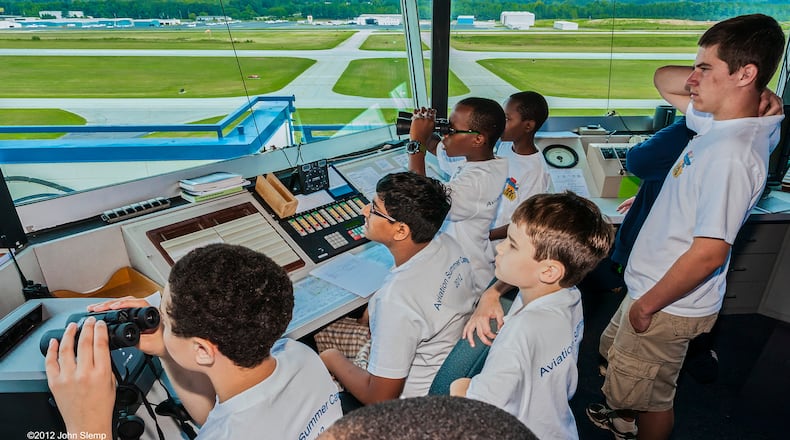In Gwinnett County, a nonprofit aviation group is helping young people to follow their dreams of becoming pilots.
Most Saturday mornings, about a dozen teens and young adults gather inside a hangar at the Gwinnett County Airport – Briscoe Field to work on aviation-related projects – like building life-sized airplanes and radio-control models.
Their work earns them flight training credits. For every 10 hours, they’ll earn one hour of training, including the use of the plane and the instructor’s time, about a $175 value.
The Youth Aviation Program, for ages 14 and up, has helped dozens of young people earn their pilot’s license and launched many more into aviation careers. The program is in its 13th year and is sponsored by the Experimental Aircraft Association chapter in Gwinnett, EAA 690.
Credit: JOHN SLEMP
Credit: JOHN SLEMP
Graduates of the program include a U.S. Naval helicopter pilot and other military and commercial pilots, including one with Delta Air Lines. Some have taken different aviation career paths through studies at Middle Georgia State University’s School of Aviation or are pursuing aerospace engineering degrees at universities such as Georgia Tech and the University of Alabama at Huntsville.
In these Saturday morning work sessions, young people “are learning to work on these planes, and we’re trying to train them,” said Billy Stewart, a retired engineer and certified private pilot who built his plane. “A lot of this is helping them learn how to succeed in a project.”
Credit: spe
Credit: spe
Stewart leads the EAA 690 youth program, and he counts on about 20 other volunteers to step in and help. Mentors are handy at working with tools; at least five have built their planes or have expertise in airplane inspections as licensed A&Ps (Airplane and Mechanic).
“Parents really love it that the kids are coming out here and learning how to work with tools and have to figure some of this stuff out and work with their hands,” Stewart said. “We get a lot of good feedback.”
EAA 690 is a local chapter of the Experimental Aircraft Association, an international organization for anyone interested in flying for fun or recreation. Based in Wisconsin, its mission is to support aviation and get the community involved.
In its 43rd year, the Gwinnett chapter has a membership of retired military, private and commercial pilots and aviation enthusiasts. They get together every first Saturday for a pancake breakfast and presentation, with other fellowship opportunities throughout the year. Several members are building airplanes inside the chapter’s hangar.
Youth involvement has always been a priority, said chapter president Louis Pucci.
Pucci said the youth program sells itself through word-of-mouth. Most planes and equipment for the work days are member donations, and the hangar was a gift from a former member when he died. Finished projects are sold to purchase other airplane kits and engines, which helps to sustain the program.
Credit: John Slemp
Credit: John Slemp
The chapter sponsors other youth activities, including Aviation Summer Camp for ages 10-18 and a Young Eagles program that gives 8- to 17-year-olds a 30-minute flight out of Briscoe Field. They also give away scholarships for flight instruction.
“The programs have been so successful and are so recognized that typically, we have more youth wanting to go to our summer camp than we have slots available,” said Pucci.
EAA 690 members have flown over 10,000 Young Eagles over the past 30 years, “a real accomplishment for the chapter,” Pucci said.
Every third Saturday with clear skies, members supply the airplane and the fuel to fly one to three youths at a time over Lake Lanier or Stone Mountain. The flights are free to the families.
During the flight, program participants wear headsets to listen to the communication between the pilot and the tower when taxiing, taking off and landing. And because the planes fly at 2,000 to 3,000 feet, participants can see the area’s geography. Pucci said those seated on the pilot’s right side might even be able to control the airplane.
“It’s a completely different experience than getting on a Delta flight and having a small window to look out at 30,000 feet,” he said.
Pucci said EAA research shows that if a Young Eagle has flown five or six times, they will likely pursue a career in aviation. “And we have a lot of youth that fly multiple times with us,” he said.
Most of the young people in the Youth Aviation Program got their introduction through Young Eagles and expressed an interest in becoming a pilot.
But it’s expensive to become a pilot, said Stewart, who estimates the beginning certificate can cost $10,000 or more. “And (most) parents don’t have this money for their kid to go out and get a pilot’s license.”
While some kids lose their pilot ambitions, there are other aviation jobs from which to choose.
Aerospace and aviation giant Boeing Global Services forecasts demand for 2.3 million new commercial pilots, technicians and cabin crew over the next 20 years.
With that in mind, youngsters in the Youth Aviation Program are learning to sheet-metal a plane, take engines apart and put them back together, and know what goes into inspecting an aircraft.
“It’s practical, hands-on stuff,” Stewart said.
HOW TO HELP
EAA 690 Youth Aviation Program is for youths age 14 and older. Meets the 2nd, 3rd and 4th Saturdays from 9 a.m.-1 p.m. EAA 690 volunteers guide youth through the process of building different airplanes. Learn more: heaa690.org.
About the Author
Keep Reading
The Latest
Featured





